Bedford Highlanders
Saying Farewell
Places > Bedford > First World War > Regiments | Bedford Highlanders Home
"Our good-byes were parched up on our lips, for Bedford had mothered us, and we had grown up as her own children." Captain Robert B. Ross, Gordon Highlanders, in 'The Fifty-first in France'.
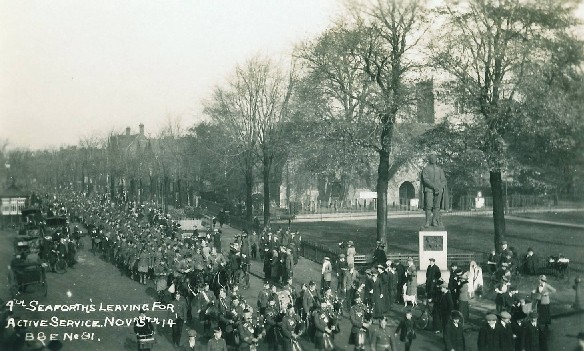
The original intention had been for Territorial units
to spend at least 6 months working-up for active
service.
However, by November 1914, the need for
reinforcements at the Front was so desperate that the
Territorials were called on to provide a number of
battalions which could be sent to France to reinforce
the British Expeditionary Force.
The 4th Seaforth
were the first to leave Bedford. They had performed well
in training, but more importantly they were up to
fighting strength following a particularly successful
recruiting drive in the early weeks of the War.
Here
they are pictured marching down De Parys Avenue, past St
Peter’s Church and John Bunyan’s statue , where they
will cross over Dame Alice Street into the High Street.
They are heading for the military railway sidings off
Ampthill Road where troop trains wait to take them to
the south coast ports and the next stage of the journey
across the Channel.
They are led by the pipes and
drums of the 5th Seaforth Highlanders and the local
population have turned out to see them on their way and
to wish them well.
(photo: courtesy of Richard
Galley)
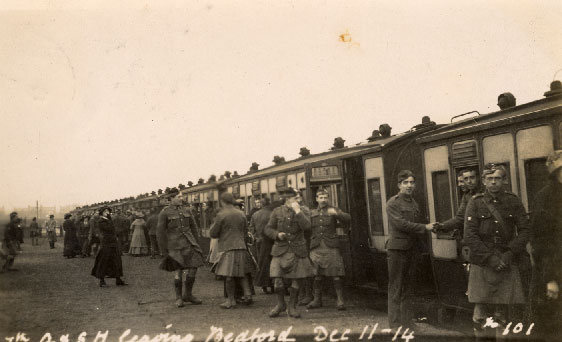
Along with the 4th Seaforth
Highlanders, the 6th Gordon Highlanders and 7th Argyll
and Sutherland Highlanders were the other infantry
battalions detached from the Highland Division in late
1914 and sent to reinforce the British Expeditionary
Force in France and Belgium.
This photograph was
taken on Friday December 11th 1914 as the entraining
soldiers of the 7th Argyll and Sutherland Highlanders
say their final goodbyes to friends and relatives, some
of whom will have travelled from Scotland to see their
menfolk off.
The troop train is standing at one of
the two long wooden platforms that had been erected by
the War Office just prior to the outbreak of war, on
derelict railway land just off Ampthill Road, in order
to facilitate the quick loading and unloading of
military trains.
(photo: Bedford and Luton Archives
and Records Service)
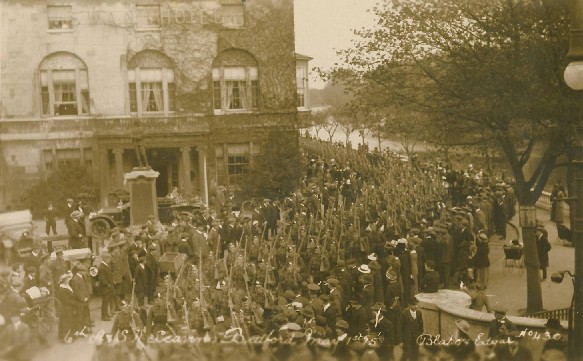
The 6th Argyll & Sutherland
Highlanders left Bedford on Saturday 1 May 1915 and in
this photo they are on their way to board the troop
trains which will take them to the South coast ports for
the onward journey to France.
They will have marched
down The Embankment alongside the river and are turning
onto the Town Bridge to cross the river. The Embankment
runs down from here to Russell Park. The Embankment and
the roads leading off it formed the Argyll &
Sutherland's billeting area. The Divisional HQ was also
on The Embankment. In the background is the Swan Hotel
with the Boer War memorial standing in front of it.
Change the styles of dress, remove the rifles from the
soldiers' shoulders and you have the present day scene
on Remembrance Sunday as the parade moves from the
Town's War Memorial half way along The Embankment
towards St Paul's church and the Market Square.
From
the Barrhead Times, May 1915:
"Departure of Local
Territorials from Bedford
A week ago a detachment of
the local [6th] battalion Argyll & Sutherland
Highlanders, who have been training in Bedford, left
that Town for active service. The Rev J Marr of Thread
Street United Free Church of Scotland Paisley, says
"Officers and the men where all in good spirits, and
looked splendid as they passed through the crowded
streets. They made very many friends in Bedford and have
left a good name behind them. I am sure they will give a
good account of themselves where-ever they go""
(photo: courtesy of Richard Galley)
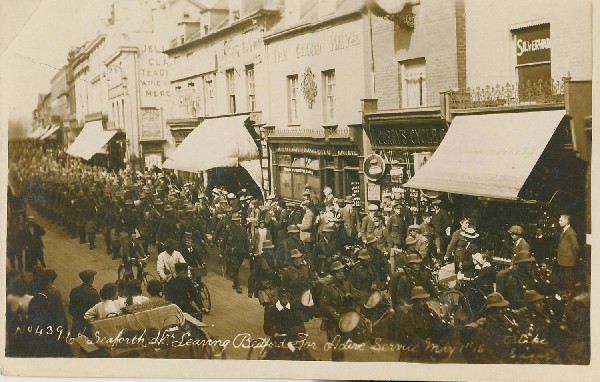
Saturday 1 May 1915 and for the
final time the 6th Seaforth's pipes and drums lead the
battalion along Bedford High Street. The Bedfordians
turned out in their thousands to bid farewell to the
Highlanders who in the space of one weekend left as
quickly as they had arrived nine months before. (Photograph: courtesy of Richard Galley)
"Bedford,
April 1915
Dear Mr Mayor,
On the Highland Division
leaving Bedford, I write to you as civic head of the
Borough to say this. The Highland Division owes much to
the Town for the manner they received and have treated
us during the nine months invasion of this peaceful
place. This we cannot adequately repay, but we shall be
grateful if you will make known these sentiments to
those concerned... Under the circumstances of the last
nine months, mistakes and inconveniences are
unavoidable; we acknowledge our share of the mistakes,
and trust that they may be forgiven. To you, personally,
I am much indebted for advice and assistance of all
sorts and I trust the good people of your town will
understand we wish them all good luck and fortune, and
hope that they will "to our faults be blind."
Believe
me,
Yours very truly,
(Signed) R. B. Allason,
Major-General,
Commanding 1/1st Highland
Division"
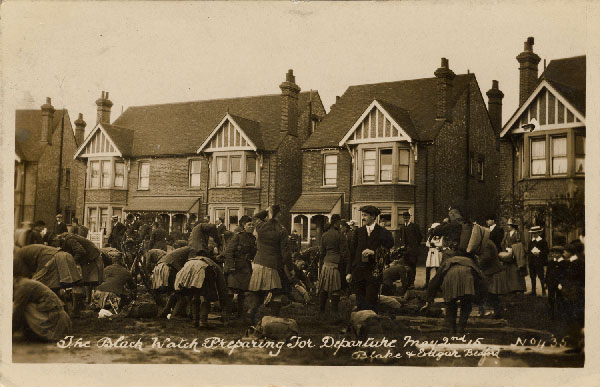
Sunday May 2nd 1915. The Black
Watch prepares to leave Bedford for France. They are
photographed in Beverley Crescent where they have been
billeted since joining the Highland Division in April.
The local residents mingle with the soldiers, no doubt
exchanging friendly banter with the Scotsmen and wishing
them well.
The civilian man in the foreground
carries an early Kodak 'Box Brownie' camera to make his
own record of the occasion, highlighting the fact that
photography was fast becoming a mass medium.
(photo:
Bedford and Luton Archives and Records Service)
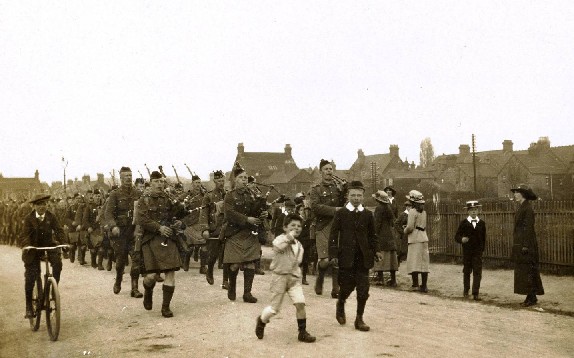
Led by the pipers, the Black
Watch make their way along Beverley Crescent to the
junction with Bromham Road where they will cross into
Hurst Grove before turning onto Ford End Road. Once
they’ve crossed the railway bridge next to W. H. Allens
they will turn into Prebend Street and make their way to
the military sidings on Ampthill Road where the troop
trains wait to take them to the south coast ports.
Behind the fence is the ground on which houses will be
built in the 1920s, completing the crescent. In the
distance are the backs of houses which stand in Spenser
Road and the telegraph poles mark the main LMS railway
line which runs north from St Pancras station in London.
(photo: Bedford and Luton Archives and Records Service)
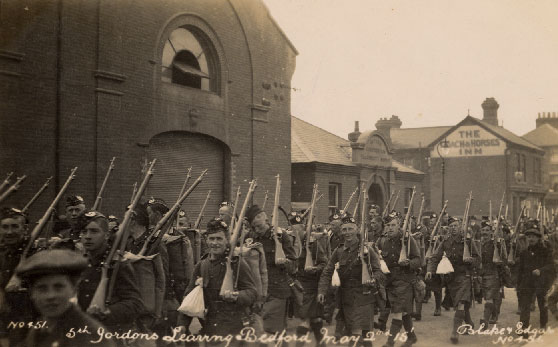
May 2nd 1915 – the 5th Gordon
Highlanders march along Prebend Street, past the
Corporation electricity works, towards the river bridge,
before heading to the temporary War Office railway
platforms in Ampthill Road where they will entrain for
one of the Channel ports from where they will make the
crossing to France.
In addition to their webbing
packs, long barrelled Lee-Enfield rifles and the other
standard accoutrements of the infantryman, each man has
a white muslin food bag hanging from his right shoulder
strap.
(photo: Bedford and Luton Archives and
Records Service)
Page last updated: 15th July 2014
